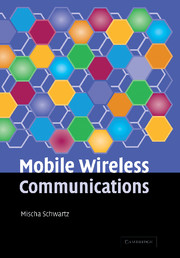Book contents
- Frontmatter
- Contents
- Preface
- 1 Introduction and overview
- 2 Characteristics of the mobile radio environment–propagation phenomena
- 3 Cellular concept and channel allocation
- 4 Dynamic channel allocation and power control
- 5 Modulation techniques
- 6 Multiple access techniques: FDMA, TDMA, CDMA; system capacity comparisons
- 7 Coding for error detection and correction
- 8 Second-generation, digital, wireless systems
- 9 Performance analysis: admission control and handoffs
- 10 2.5G/3G Mobile wireless systems: packet-switched data
- 11 Access and scheduling techniques in cellular systems
- 12 Wireless LANs and personal-area networks
- References
- Index
4 - Dynamic channel allocation and power control
Published online by Cambridge University Press: 05 June 2012
- Frontmatter
- Contents
- Preface
- 1 Introduction and overview
- 2 Characteristics of the mobile radio environment–propagation phenomena
- 3 Cellular concept and channel allocation
- 4 Dynamic channel allocation and power control
- 5 Modulation techniques
- 6 Multiple access techniques: FDMA, TDMA, CDMA; system capacity comparisons
- 7 Coding for error detection and correction
- 8 Second-generation, digital, wireless systems
- 9 Performance analysis: admission control and handoffs
- 10 2.5G/3G Mobile wireless systems: packet-switched data
- 11 Access and scheduling techniques in cellular systems
- 12 Wireless LANs and personal-area networks
- References
- Index
Summary
In Chapter 3 we discussed channel allocation in a cellular environment with reuse constraints built in to keep interference to a tolerable level. The reuse constraints reduce the number of channels that can be allocated to each cell, reducing thereby the improvement in system traffic capacity expected through the use of the cell concept. Various strategies have been proposed and/or adopted to obtain further improvement in system performance. The use of directional antennas to reduce the number of interfering signals with which a desired signal has to contend is one possibility (Stüber, 2001). This procedure has, in fact, been adopted in current cellular systems. Another approach is that of reducing cell size, hence gaining more cells in a geographic region, with consequent increase in capacity, with a given reuse characteristic included. Cellular systems are, in fact, moving toward a hierarchy of cell sizes: larger cells, called macrocells; microcells, to be used, ideally, in the more crowded urban environments where the traffic load does dictate reducing the cell size (base station antennas and their attendant transmitter–receiver systems may be located at the reduced height of street lamp posts); and picocells, to be used principally in indoor cellular systems. One problem with the microcell approach is that handoffs, to be discussed in Chapter 9, become more frequent, increasing the need to handle handoff calls more effectively. Macrocell overlays on microcellular systems have been proposed as well to improve traffic-handling capability (Stüber, 2001).
- Type
- Chapter
- Information
- Mobile Wireless Communications , pp. 81 - 106Publisher: Cambridge University PressPrint publication year: 2004



